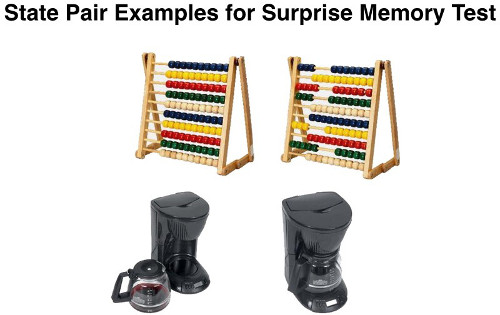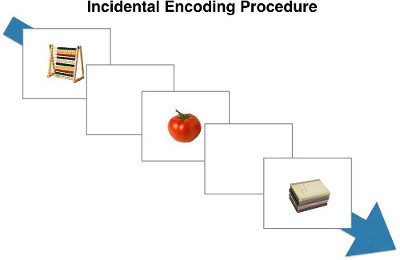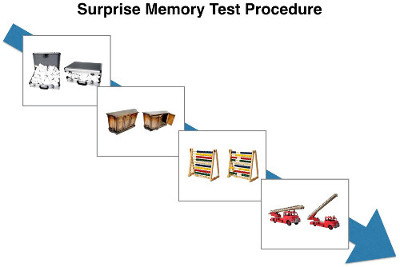付随のエンコーディング
概要
ソース: ジョナサン ・ Flombaum 講座-ジョンズ ・ ホプキンス大学
長期記憶は人間の認知の重要な機能と、実験心理学の研究の著名な中心だった。長期記憶を活用するように設計多くのパラダイムは、参加者に学ぶやコンテンツ、そのコンテンツに関するテストのメモリに依存します。これは良いアプローチ 1 つはメモリが教育達成などをサポートする方法を理解したい場合明示的な研究がプロセスの一部であります。しかし、日々 の生活で人々 はしばしば新しい記憶の形成-長い時間の最後の多く-ちなみに.好きな物語のプロットやパートナーが満たされた瞬間雑誌で読んでる人を覚えていないためにしようとします。どういうわけか、経験の良い取引だけエンコードされるメモリに人生が経つにつれて。長期記憶のこの側面を研究、実験心理学者は偶発的符号化パラダイムと呼ばれるものを使用します。
パラダイム、強力な長期的な記憶を生成する傾向がある経験の種類を調査するため便利です。研究者が彼らを要求約束のような面で経験を考える-個人、純粋な知的、深い、またはたとえば、浅い。偶発的符号化パラダイムは、刺激する個人を公開するために使用カバー タスクを変化させることにより各種婚約中に長期記憶の形成の対比を使用できます。カバー タスク参加者は刺激タスクでメモリを知らなくても完了です後でテストに求められるタスクです。
このビデオでは、付随的符号化パラダイムと 2 つの異なるカバー タスクを使用して、刺激の明示的な研究を要求しないときに長期記憶を調査するための標準的な手順を示します。
手順
1. 刺激と装置。
- コンピューターで実験を実行します。
- 現実世界での日常のオブジェクト (図 1) の写真のセットを収集します。

図 1.付随をエンコードするための刺激をサンプルします。典型的な実験は、ここに示す 5 のような日常のオブジェクトのカラー写真を利用します。多くのラボは、公に利用できるこのような刺激セットを作る。これらの例は、mit グループから: http://cvcl.mit.edu/MM/uniqueObjects.html。 - 、該当する各画像には、画像内のオブジェクトは同じではなく別の状態 (図 2)、対ケースを作成します。

結果
申請書と概要
タグ
スキップ先...
このコレクションのビデオ:

Now Playing
付随のエンコーディング
Cognitive Psychology
8.6K 閲覧数

聴テ
Cognitive Psychology
26.7K 閲覧数

減算の反応時間とドンダースの測定
Cognitive Psychology
44.4K 閲覧数

機能や接続詞の視覚探索
Cognitive Psychology
26.9K 閲覧数

認知心理学の視点
Cognitive Psychology
7.0K 閲覧数

両眼視野闘争
Cognitive Psychology
8.0K 閲覧数

複数物体追跡
Cognitive Psychology
7.8K 閲覧数

おおよその感覚テスト
Cognitive Psychology
7.6K 閲覧数

心的回転
Cognitive Psychology
13.2K 閲覧数

プロスペクト理論
Cognitive Psychology
11.2K 閲覧数

言語的作動記憶容量を測定
Cognitive Psychology
12.5K 閲覧数

視覚ワーキング メモリ遅延推定精度
Cognitive Psychology
5.2K 閲覧数

ことばによるプライミング
Cognitive Psychology
15.0K 閲覧数

統計学習
Cognitive Psychology
7.1K 閲覧数

鏡映描写の運動学習
Cognitive Psychology
55.6K 閲覧数
Copyright © 2023 MyJoVE Corporation. All rights reserved

